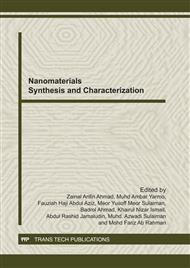p.115
p.119
p.124
p.129
p.134
p.139
p.144
p.149
p.154
Properties of Amorphous Silica Entrapped Isoniazid Drug Delivery System
Abstract:
This work describes the properties of silica drug delivery system (DDS) produced using micelles entrapment approach. Isoniazid, which is a water soluble drug for tuberculosis was used in the system. The effects of synthesis parameters were systematically studied such as synthesis temperature (38-70°C), amount of butanol co-solvent (6-18 ml), and amount of Si organic precursor (2-8 ml). From transmission electron microscope (TEM) images, the size of DDS could be tuned from 21-104 nm by changing the reaction temperature. The increase of butanol co-solvent enlarged the size of DDS in the range of 40-94 nm. A similar trend was observed for DDS with increasing organic Si precursor whereby the particle size could be tuned from 40-132 nm. However, at high organic Si precursor of > 2 ml, a bimodal structure of DDS was observed. Stability study in biological media at 37°C of selected sample showed that the produced DDS had acceptable degree of agglomeration.
Info:
Periodical:
Pages:
134-138
Citation:
Online since:
October 2011
Keywords:
Price:
Сopyright:
© 2012 Trans Tech Publications Ltd. All Rights Reserved
Share:
Citation:


